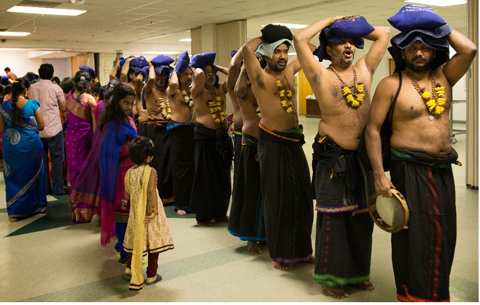
ST LOUIS: The Hindu Temple of St Louis celebrated Mandala Pooja for Lord Ayyappa on December 25, 2013.
Lord Ayyappa or Dharma Shastha represents a combination of spiritual powers symbolized by the forms of Lord Vishnu, the power that maintains the universe, and Lord Shiva, the power that periodically reabsorbs the manifestations into reality.
The Ayyappa Vratham culminates in a final Mandala festival where Ayyappa swamis (devotees who observe Ayyappa Vratham) take coconuts filled with ghee (called Irumudi, representing mind and body) and offer them to Lord Ayyappa. This is a strict, spiritually disciplined process and it symbolizes offering the mind and body to Lord Ayyappa, including the ‘ego’.
Through the entire process the swamis purify their mind in order to achieve a deeper level of self-realization. On Dec 24 and early morning of Dec 25, Ayyappa swamis filled the polished coconut with ghee and devotees chanted -‘swamiye..swamiye’ during the ghee filling with the vibration of Lord Ayyappa and the surrendering of ego.
During the intermittent time of ghee filling, swamis and devotees sing Ayyappa bhajans and Vazhinadai Saranams for His blessings. On Dec 25, Irumudi Pooja was performed by Guruswamy marking the completion of Irumudi preparation. In spite of the cold weather outside, Swamis including kid swamis went round the temple three times with bare foot chanting Vazhinadai Saranams, taking the Irumudi to Lord Ayyappa. Shantha Swaroopa Dharshan for spiritual happiness.
After reaching the main hall, the Muthirai Thengai (coconut filled with ghee) and all other Abishekam materials were taken out and given to temple priests for Ayyappa Nei Abishekam. The temple priests performed Abishekam poojas with Nei Abishekam the salient feature. Kid swamis chanted bhajans showing love for Lord Ayyappa.
Alankarana of Lord Ayyappa in Shantha Swaroopa posture with all ornaments and floral decorations followed.
Devotees were taken to their peak of spiritual fervor when the eighteen steps were lit accompanied by Padi Paatu that essentially marked the morning festival. All swamis were offered Anna Dhana in traditional Indian style.
On 25th evening, divine bhajan was sung by all swamis and devotees. Seeveli, the procession of Ayyappa Vurchavar with drums, dance, and chanting of songs were witnessed by hundreds of devotees. Carrying of lamps, representing removal of ignorance to seek jyothi by ladies in the traditional Kerala style was also a part of Seeveli.
After Seeveli, Lord Ayyappa provided Basmabhishekam Dharshan from his Uyyalu in order to mark tranquility and peace. This was accompanied by few more songs and Harivarasanam to put Lord Ayyappa to sleep and rest. The divine presence of Lord Ayyappa was realized throughout the day.
Ashwin Patel






